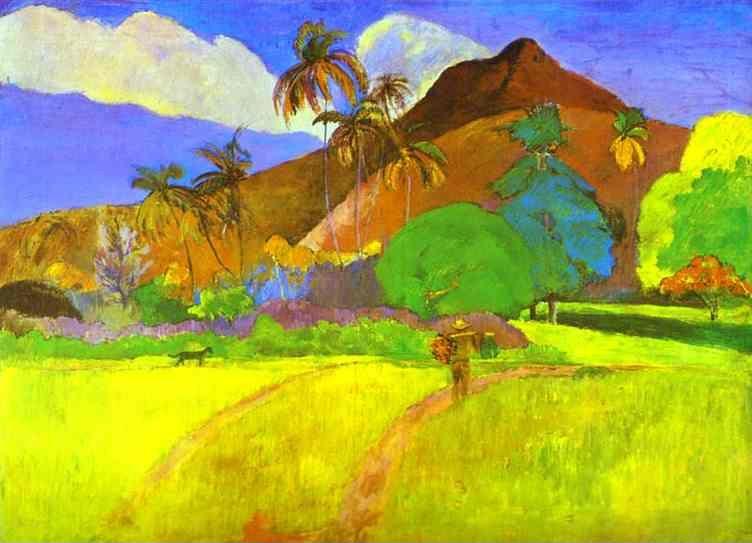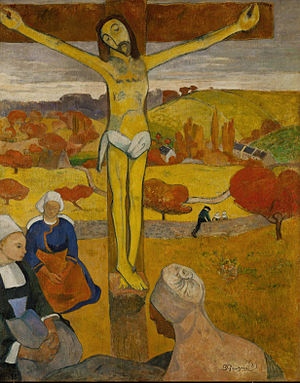It has been a century since these leaders in innovation were at their primes; each bringing forward artistic rebellion in their differing art forms.
Gauguin’s last retrospective in London was 50 years ago; he was then seen as ‘Gauguin the savage’, a notorious artist of the 19th century whom which people referred to him as ‘the artist that goes to Tahiti’, enthralling the local young Tahitians, living the life of paradise he always sought after. But fast forward a 100 years later and Gauguin is seen as a hero, if you like, the 20th century artist’s liberator; artists benefit from his legacy and many of the –isms of art in the 20th century, for instance Primivitism and Symbolism owe it to Gauguin for that artistic freedom. He adopted a ‘right to dare policy’, he abhorred restraints in civilisation, renouncing and defying the notions of traditional Western art. He argues that art should go beyond material appearances, developing a simplified visual language to explore complex ideas and construct poetic meaning.
Travelling to the remote corners of the world, Gauguin was worldly-wise, cultured and cultivated; having travelled and lived in South America – Peru – for the first four years of his life, the country whose colourful imagery was to influence his later works. One of his early works from Martinique, Tahitian Landscape, 1893 for example boasts an intense symphony rich in colour and a non-naturalistic palette. Coloured in vivid greens, mauves, yellows and oranges; the simplified shapes and keen colour portray his idyllic landscape, dissimilar to the pictographic terrain of Pont-Aven, with its rolling hills and an atmosphere seemingly untouched by time.
 |
| 'Tahitian Landscape', 1893 |
 |
| 'Yellow Christ', 1889 |
Out of all the Impressionists, Gauguin was undoubtedly the most flamboyant and intelligent. Although he rejected religion, a lot of his works have religion as a feature. The heady fierce colour and strange symbolism that hallmarks in Yellow Christ of 1889 depicts a the crucifixion of Christ on the rolling Breton hills of Arles; the autumnal palette brags the autonomous yellow of his flesh – perhaps an influence from having lived with Van Gogh - which is then resonated in the landscape behind. The limited depth of the figures and bold outlines are typical characteristics of cloisonnisme.
Equally lurid were his hand-carved lintels which he made as an entrance to his bedroom, in which he carved the inscription: ‘Maison du Jouir’, translating to ‘House of Pleasure’. A confrontational message, which proved to provoke particular neighbours (Catholic bishops).
In the heart of the exhibition, it’s impossible to miss the one painting that continually attracts a mass of people like moths to a flame. The famed figure of a pensive Tahitian girl reclining on a bed – inscrutable Nevermore O Tahiti, 1897, bearing references to Edgar Allan Poe’s poem The Raven and a physical presence of the raven itself perched on the window. The otherwise dimly tinted canvas, shadowed by the omen that is the raven is kindled by her bright shoulders and a favourite of Gauguin’s – the jovial yellow of the pillow. The sensual, seductive contours of the woman are echoed in the frame of the bed and for a moment there is a slight hint of irritation in her expression.
 |
| 'Nevermore O Tahiti', 1897 |
The show promised to be one of the most anticipated exhibitions at the Tate for 2010, and the Tate has succeeded in delivering a coherently curated exhibition. Eleven rooms are cleverly divided thematically and chronologically; the opening gallery consisting of a progression of self portraits from both Paris and Tahiti. It becomes plain to see how Gauguin can be so adaptive and responsive to his surroundings. As you snake around the rooms, one gains a sense of Gauguin breaking bonds with the microcosm of the Western world, as he attaches himself to Tahiti, he distances himself geographically and thematically; people viewing him as something ‘other’, exotic, but not a term said with some distance. This is a brilliant show, shedding new light upon Gauguin and illuminating his intelligence and the way he incorporated his ideals and thoughts fearlessly onto canvas.
Diaghilev the patron, the dictator, the innovator founded and united the art forms in his Ballets Russes and the greatest artistic minds of the 20th century. His undisputed greatest achievement was his dance company the Ballets Russes, radically transforming the nature of ballet, its subject matter, choreographic principles, music, set design, costume, nurturing some of the greatest dancers, and bringing together forward looking composers. The Ballet Russes seemed immersed, obsessed even in experimenting, exploring new potentials and horizons for ballet.
The exhibition takes the time to consider individuals and related collections. A lofty curtain hangs conspicuously, spanning from the ceiling to the floor; the towering coral-rose female characters, caught in motion serve as hints to those to look up in awe of the magnitude of the stage. This was the work of Picasso, who painted the drop curtain for the ballet Le Train Bleu from 1924. This is a new horizon Picasso, who by then was deep in the realm of cubism, diverting into the playfulness of decor. Le Train Bleu also saw the works of Chanel, having the dancers sporting shift-dress-like bathing suits.
 |
| The curtain for Le Train Bleu, 1924 |
 |
| Costumes for Le Train Bleu, by Coco Chanel |
A large section focuses on Nijinsky, to which the Ballets Russes had to thank for his unusually pioneering choreography. A video containing extracts from Pina Bausch’s choreography to Stravinsky’s Rite of Spring saw a new urgency in the dancing; the female solo pulling herself across the stage, the sheer tension on her face, while idle individuals around her suddenly come to life, equating their actions to the sharp bends in the music.
Costume design discovered new spheres as the traditionally tight fitting costumes of ballet were replaced by the likes of looser, heavier and decor elaborated attire influenced and infusing the old and new together; 18th century luxury and 20th century novelty. Surely, the weight of luxury-encrusted costumes would hinder the dancers? That may have been, but there is no indication of such problem when viewing the photographs of Nijinsky suspended in the air, performing one of his renowned jumps.
With the many rooms in this exhibition and the crossing between visual art, dance and music, it’s hard not to feel like a spectator attending a very complete show, what with its elements of projection performance; edited extracts of Stravinsky’s Firebird and other productions, glittering costumes on rotating plinths and an incredible ambience, it’s all like a production itself. There’s something there for everyone, a fabulously all-in-one show.


















































